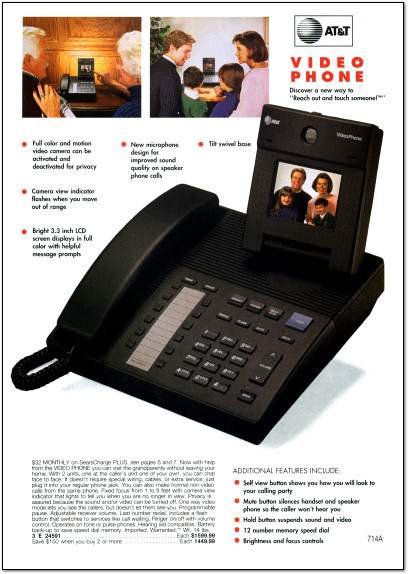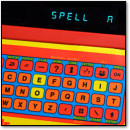[ Retro Scan of the Week ] AT&T VideoPhone 2500
June 14th, 2010 by Benj Edwards “Discover a new way to ‘Reach out and touch someone!'”
“Discover a new way to ‘Reach out and touch someone!'”
AT&T launched the VideoPhone 2500 in 1992 with high hopes that it would finally bring video calling to the masses. Ultimately, it fared no better than AT&T’s previous attempts at commercial video phones, all of which exited the market quickly after their introduction.
For $1599.99 ($2,486.19 in 2010 dollars), you received a single phone unit that could send audio and color video (at up to ten frames per second) simultaneously over a regular phone line. It worked its magic through a 19.2 kbps data stream, which is minuscule by today’s standards, but was state of the art in 1992. Unfortunately, the video functionality of the VideoPhone 2500 was useless without another $1599.99 phone to interact with — perhaps the fatal flaw in AT&T’s plan.
If you’re interested in learning more about the history of video telephone technology, check out my latest Technologizer slideshow, 132 Years of Videophones.
Discussion Topic of the Week: If you owned an easy-to-use videophone device — and everyone else had one — how often do you think you’d use its video functionality?






June 14th, 2010 at 1:16 pm
I do have an easy-to-use videophone device, and everyone else has one too. Instant Messenger. Most clients have voice and video chat functionality built into them (personally, I use AIM, but it doesn’t matter). So you can talk and see each other online through them.
So it actually is nigh ubiquitous already. It’s just not sold as a phone.
I use it maybe once every 2-3 months, so not that often at all. And that’s with people I’d -want- to see, nevermind every telemarketer or corporate caller out there.
June 14th, 2010 at 3:17 pm
I don’t think I’d ever want a video phone. I hate being on the phone and I use any number of excuses to get off the phone. If people could see me on the phone, this would make the excuses much more difficult.
June 14th, 2010 at 5:31 pm
The problem with videophones is that people don’t want to be seen as they usually are when just bumming around the house…. If they knew they were going to be on video, they’d have to go through the whole ordeal of brushing their hair, putting on makeup, and wearing some nice clothes…..
“Oh no, someone’s calling! I better check my hair and face in a mirror!”
June 15th, 2010 at 8:32 am
While all the above complaints are true, I think Apple’s iPhone 4 video sums up what they have in mind, and what may well finally be a videophone hit. The key: the iPhone 4 is truly portable, unlike a laptop let alone the traditional desktop + webcam, or the classic videophones of old.
It’s like the difference between a full-size TV camera and a pocket sized Flip. Or a high end DSLR and a pocketable point and shoot … or indeed a smart phone.
The whole problem has always been ubiquity. Everyone else must have the hardware too (which before webcams they never did) and everyone else must have it with them when something worth doing in video is going on (which only non-live pocket sized video cameras like the Flip have managed). The iPhone 4 should hit the spot. And, all the more importantly, Apple’s smart enough not to hold onto the protocol themselves so we should see it everywhere.
I still doubt we’ll see large fixed screen home videophones though. But never is a very long time and I’m not touching it.
June 16th, 2010 at 5:00 pm
Is anyone actually kicking themselves for buying this? I doubt it 🙂 Not at 1500 bucks. I doubt anyone would even admit to dishing out that dough.
June 16th, 2010 at 6:42 pm
One time in every 356
June 18th, 2010 at 10:03 am
This is quite an interesting scan! Back in the early 1990s, my dad had actually purchased two of these. One, we kept on his desk in our home, right next to the 286 PC I’m sure, and the other, we sent to his mother on the other side of the country.
It worked, but just barely. The lines in her part of the country are extremely old, so even if it’s capable of transmitting video at 19.2kbps, I’m pretty sure ours never achieved that speed.
Because of that (and the overall state of the technology at the time), the picture was always very muddy and dark, the picture was never in good synchronization with the audio, and if you actually wanted to have a real conversation with the person on the other end, it was a far better idea to just give them an audio call.
I personally suspect that for the reasons stated earlier, the iPhone4 will have a far better and more widespread use in terms of video chatting on a regular basis. There are just so many uses for technology like that, that’s so mobile. You don’t have to dress up specifically for the call, you can make the call while you’re choosing an outfit, as one example given in the introduction video for the technology, or you could make the decision to call somebody once you’ve gotten to work and maybe you’re a few moments early, but are hanging out within the vicinity of a wifi access point, or maybe you’re calling family.
Additionally, I suspect that it’ll gain traction with video sharing websites such as Qik and even the mentioned/shown iMovie functionality, for composing multimedia projects with footage gathered from both cameras, audio recorded with the device and photos taken with both cameras.
Very interesting times, indeed.
June 18th, 2010 at 8:59 pm
They sell something similar today called the Beamer by a company named Vialta. http://www.vialta.com/
February 8th, 2011 at 1:26 am
You know, Australia got video calling on mobile phones in the early 2000’s; almost every phone has it because we had a big 3G network from the get-go.
But hardly anyone used it because it costs more than a normal call, and you just get to look up someone’s nostrils in a dark or overly bright environment, while struggling to hear them. Not very cool; but good if you need to show something in a pinch (or haven’t seen your brother in a few months).
December 19th, 2013 at 3:41 am
When these became available at Circuit City some of my friends and I bought a total of
Four of them. The actually worked well, we were all in the same city all at&t customers.
After a year or so we received certified letters from at&t saying that they are no longer
Going to support the device. We were offered a voucher for half the cost of the phones for other att equipment or keep the phone but if it failed we were on our own as no parts would
be available. We tried to get cash refunds, but no. Two of us kept them and after the lcd back light failed so we took apart some fluorescent night lights and got them to work. By then Skype was hitting the market, we kept using them as phones because the speaker phone was a full duplex and the number dialed (sorry, entered) would come up on the
Lcd screen with other information. BTW, the power supply for the video phone was the
size of a shoe box and weighed over 10 pounds. It had a thick multi conducter cable that
ran to the phone.
Size of a shoe box and weighed over 10 pounds. Thick multi conducter cable ran
January 17th, 2017 at 12:49 pm
Does somebody know how to introduce phone numbers in the videophone 2500?
September 28th, 2021 at 3:18 pm
I was one of the 3 modem developers for the Videophone 2500.
Rick Flanagan and Bill Betts (brains).
It had proprietary modem, proprietary speech coder and proprietary video coder.
Our boss had to take a trip to Washington DC to explain how it all worked for the NSA, CIA and FBI, because it was effectively self encrypting.